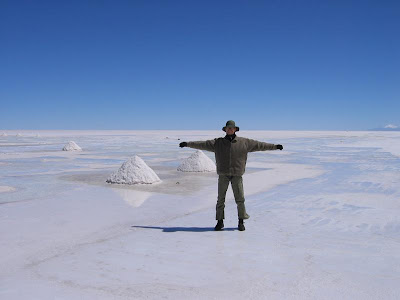The world’s largest salt flat, the Salar de Uyuni in Southwestern Bolivia, is one of the most exotic place sceneries on earth. Due to its large size, smooth surface, high surface reflectivity when covered with shallow water, and minimal elevation deviation, Salar de Uyuni makes an ideal target for the testing and calibration of remote sensing instruments on orbiting satellites used to study the Earth. In addition to providing an excellent target surface the skies above Salar de Uyuni are so clear, and the air so dry, that the surface works up to five times better for satellite calibration than using the surface of the ocean.

There is an estimated 10 billion tons of salt in the flats, 25 times the amount in the Bonneville Salt flats in Utah in the United States. The Salar de Uyuni, a sea of salt, a salt desert, was once an inland sea, or giantsalt water lake, but the water vanished into the thin dry air of Andean altitude. All that remains is the salt, tens of meters thick, lying stark beneath bright sky: a sun-bleached skeleton of a dead sea.















 There is an estimated 10 billion tons of salt in the flats, 25 times the amount in the Bonneville Salt flats in Utah in the United States. The Salar de Uyuni, a sea of salt, a salt desert, was once an inland sea, or giantsalt water lake, but the water vanished into the thin dry air of Andean altitude. All that remains is the salt, tens of meters thick, lying stark beneath bright sky: a sun-bleached skeleton of a dead sea.
There is an estimated 10 billion tons of salt in the flats, 25 times the amount in the Bonneville Salt flats in Utah in the United States. The Salar de Uyuni, a sea of salt, a salt desert, was once an inland sea, or giantsalt water lake, but the water vanished into the thin dry air of Andean altitude. All that remains is the salt, tens of meters thick, lying stark beneath bright sky: a sun-bleached skeleton of a dead sea.














No comments:
Post a Comment